A Scalable Segmented-Based PEM Fuel Cell Hybrid Power System Model and Its Simulation Applications
Abstract
:1. Introduction
2. Model Description
2.1. Physical Modeling Concept
2.2. Fuel Cell Model
2.3. Battery Model
2.4. DC-DC Converter Model
2.5. Single/Segmented Fuel Cell–Battery Hybrid Power System
- Fuel cell: output voltage and current should be coupled according to the polarization curve to satisfy the fuel cell’s characteristics.
- Battery: output voltage and current should be coupled according to the battery charge–discharge curve to satisfy the battery’s characteristics. is related to its open-circuit voltage , SOC, and current demand.
- DC-DC converter: it obeys the law of conservation of energy.
- Load: the output voltages of the load (), battery (), and DC-DC () converter are equal. The load gives the total current demand , the output current is allocated by the EMS, and the battery complements the residual current demand automatically. When the load demand is smaller than , turns negative and the battery is charged.
3. Energy Management Strategy
- The load current demand should be satisfied during dynamic scenarios.
- The rate of current change demand of the FC should be maintained within an appropriate range by considering its dynamic constraints. Correspondingly, a limitation on the rate of current change demand for the DC-DC converter should be set.
- The output current of the FC has limitations. Correspondingly, the DC-DC converter output current should be limited.
- The SOC should be above the warning line and maintained within an appropriate range to keep the battery’s output voltage in a relatively stable state.
- Mode 1: . The fuel cell tries to satisfy the load current demand with the limitation of the DC-DC converter’s rate of current change.
- Mode 2: . The fuel cell should follow the change in load current demand and reach its appropriate operating state.
- Mode 3: . The battery needs charging.
- Mode 4: The SOC of the battery reaches the warning line. In this case, the battery must charge, .
- Mode 5: . In this case, excessive charging should be avoided, and the output current of the DC-DC converter should be appropriately reduced. If the load current demand is low (idle, start–stop phase), the fuel cell output current can be reduced below the appropriate operating current.
4. Simulation Results and Discussions
- Performance of the single-fuel-cell hybrid power system.
- Performance of the single-fuel-cell hybrid power system with a low-battery SOC situation.
- Performance of the ()-segment fuel cell hybrid power system.
4.1. Single-Fuel-Cell Hybrid Power System
- Part 1 (0–500 s): low current demand and several no-current-demand sections.
- Part 2 (500–1000 s): the current demand increases, and the fluctuation becomes more drastic.
- Part 3 (1000–1500 s): small current fluctuation, and the average power demand is the largest among the three parts.
4.2. Single-Fuel-Cell Hybrid Power System with Low-Battery SOC Situation
4.3. Hybrid Power System with ()-Segment Fuel Cell
5. Conclusions
Author Contributions
Funding
Data Availability Statement
Conflicts of Interest
References
- Hu, Z.; Li, J.; Xu, L.; Song, Z.; Fang, C.; Ouyang, M.; Dou, G.; Kou, G. Multi-objective energy management optimization and parameter sizing for proton exchange membrane hybrid fuel cell vehicles. Energy Convers. Manag. 2016, 129, 108–121. [Google Scholar] [CrossRef]
- Jiang, W.; Fahimi, B. Active Current Sharing and Source Management in Fuel Cell–Battery Hybrid Power System. IEEE Trans. Ind. Electron. 2010, 57, 752–761. [Google Scholar] [CrossRef]
- Huang, L.; Chen, J.; Liu, Z.; Becherif, M. Adaptive thermal control for PEMFC systems with guaranteed performance. Int. J. Hydrogen Energy 2018, 43, 11550–11558. [Google Scholar] [CrossRef]
- Chen, J.; Huang, L.; Yan, C.; Liu, Z. A dynamic scalable segmented model of PEM fuel cell systems with two-phase water flow. Math. Comput. Simulat. 2020, 167, 48–64. [Google Scholar] [CrossRef]
- Li, Q.; Chen, W.; Liu, Z.; Li, M.; Ma, L. Development of energy management system based on a power sharing strategy for a fuel cell-battery-supercapacitor hybrid tramway. J. Power Sources 2015, 279, 267–280. [Google Scholar] [CrossRef]
- Wu, C.; Chen, J.; Xu, C.; Liu, Z. Real-Time Adaptive Control of a Fuel Cell/Battery Hybrid Power System with Guaranteed Stability. IEEE Trans. Control Syst. Technol. 2017, 25, 1394–1405. [Google Scholar] [CrossRef]
- Meng, X.; Li, Q.; Zhang, G.; Wang, T.; Chen, W.; Cao, T. A Dual-Mode Energy Management Strategy Considering Fuel Cell Degradation for Energy Consumption and Fuel Cell Efficiency Comprehensive Optimization of Hybrid Vehicle. IEEE Access 2019, 7, 134475–134487. [Google Scholar] [CrossRef]
- Li, Q.; Wang, T.; Dai, C.; Chen, W.; Ma, L. Power Management Strategy based on Adaptive Droop Control for a Fuel Cell-Battery-Supercapacitor Hybrid Tramway. IEEE Trans. Veh. Technol. 2018, 67, 5658–5670. [Google Scholar] [CrossRef]
- Hu, X.; Murgovski, N.; Johannesson, L.M.; Egardt, B. Optimal Dimensioning and Power Management of a Fuel Cell/Battery Hybrid Bus via Convex Programming. IEEE/ASME Trans. Mechatron. 2014, 20, 457–468. [Google Scholar] [CrossRef]
- Xu, L.; Mueller, C.D.; Li, J.; Hu, Z.; Ouyang, M. Multi-objective component sizing based on optimal energy management strategy of fuel cell electric vehicles. Appl. Energy 2015, 157, 664–674. [Google Scholar] [CrossRef]
- Fernandez, L.M.; Garcia, P.; Garcia, C.A.; Francisco, J. Hybrid electric system based on fuel cell and battery and integrating a single dc/dc converter for a tramway. Energy Convers. Manag. 2011, 52, 2183–2192. [Google Scholar] [CrossRef]
- Simmons, K.; Guezennec, Y.; Onori, S. Modeling and energy management control design for a fuel cell hybrid passenger bus. J. Power Sources 2014, 246, 736–746. [Google Scholar] [CrossRef]
- Li, Q.; Su, B.; Pu, Y.; Han, Y.; Chen, W. A state machine control based on equivalent consumption minimization for fuel cell/supercapacitor hybrid tramway. IEEE T. Transp. Electr. 2019, 5, 552–564. [Google Scholar] [CrossRef]
- Wang, T.; Qiu, Y.; Yin, L.; Liu, L. Efficiency extreme point tracking strategy based on FFRLS online identification for pemfc system. IEEE Trans. Energy Convers. 2019, 34, 952–963. [Google Scholar] [CrossRef]
- Hu, X.; Liu, S.; Song, K.; Gao, Y.; Zhang, T. Novel fuzzy control energy management strategy for fuel cell hybrid electric vehicles considering state of health. Energies 2021, 14, 6481. [Google Scholar] [CrossRef]
- Jaafar, A.; Turpin, C.; Roboam, X.; Bru, E.; Rallieres, O. Energy management of a hybrid system based on a fuel cell and a Lithium Ion battery: Experimental tests and integrated optimal design. Math. Comput. Simulat. 2017, 131, 21–37. [Google Scholar] [CrossRef]
- Kandidayeni, M.; Macias, A.; Boulon, L.; Kelouwani, S. Efficiency Enhancement of an Open Cathode Fuel Cell Through a Systemic Management. IEEE Trans. Veh. Technol. 2019, 68, 11462–11472. [Google Scholar] [CrossRef]
- Chen, J.; Xu, C.; Wu, C.; Xu, W. Adaptive Fuzzy Logic Control of Fuel-Cell-Battery Hybrid Systems for Electric Vehicles. IEEE Trans. Industr. Inform. 2018, 14, 292–300. [Google Scholar] [CrossRef]
- Yan, Y.; Li, Q.; Chen, W.; Huang, W.; Liu, J. Hierarchical Management Control Based on Equivalent Fitting Circle and Equivalent Energy Consumption Method for Multiple Fuel Cells Hybrid Power System. IEEE Trans. Ind. Electron. 2019, 67, 2786–2797. [Google Scholar] [CrossRef]
- Yan, Y.; Li, Q.; Chen, W.; Su, B.; Liu, J.; Ma, L. Optimal Energy Management and Control in Multimode Equivalent Energy Consumption of Fuel Cell/Supercapacitor of Hybrid Electric Tram. IEEE Trans. Ind. Electron. 2019, 66, 6065–6076. [Google Scholar] [CrossRef]
- Sellali, M.; Ravey, A.; Betka, A.; Kouzou, A.; Benbouzid, M.; Djerdir, A.; Kennel, R.; Abdelrahem, M. Multi-objective optimization-based health-conscious predictive energy management strategy for fuel cell hybrid electric vehicles. Energies 2022, 15, 1318. [Google Scholar] [CrossRef]
- Jia, J.; Li, Q.; Wang, Y.; Cham, Y.T.; Han, M. Modeling and Dynamic Characteristic Simulation of a Proton Exchange Membrane Fuel Cell. IEEE Trans. Energy Convers. 2009, 24, 283–291. [Google Scholar] [CrossRef]
- Mann, R.; Amphlett, J.; Hooper, M.; Jensen, H.; Peppley, B.; Roberge, P. Development and application of a generalized steady-state electrochemical model for a pem fuel cell.journal of power sources. J. Power Sources 2000, 86, 173–180. [Google Scholar] [CrossRef]
- Beater, P. Pneumatic Drives/System Design, Modelling and Control; Springer: Berlin/Heidelberg, Germany, 2007; pp. 30–35. [Google Scholar]
- Battery. MATLAB/Simscape. Available online: https://ww2.mathworks.cn/help/sps/powersys/ref/battery.html (accessed on 1 August 2023).
- Han, Y.; Li, Q.; Wang, T.; Chen, W.; Ma, L. Multisource Coordination Energy Management Strategy Based on SOC Consensus for a PEMFC–Battery–Supercapacitor Hybrid Tramway. IEEE Trans. Veh. Technol. 2018, 67, 296–305. [Google Scholar] [CrossRef]

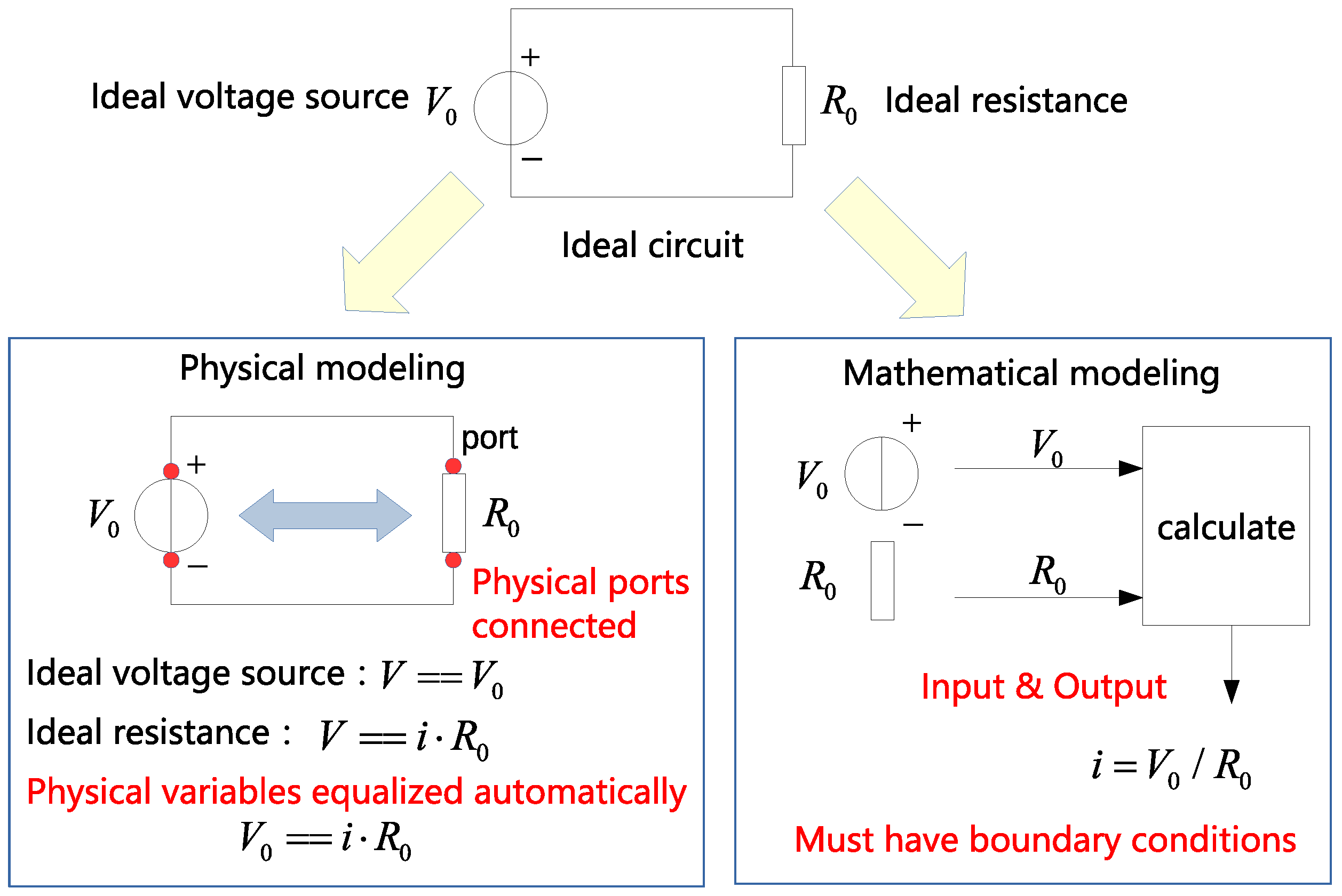

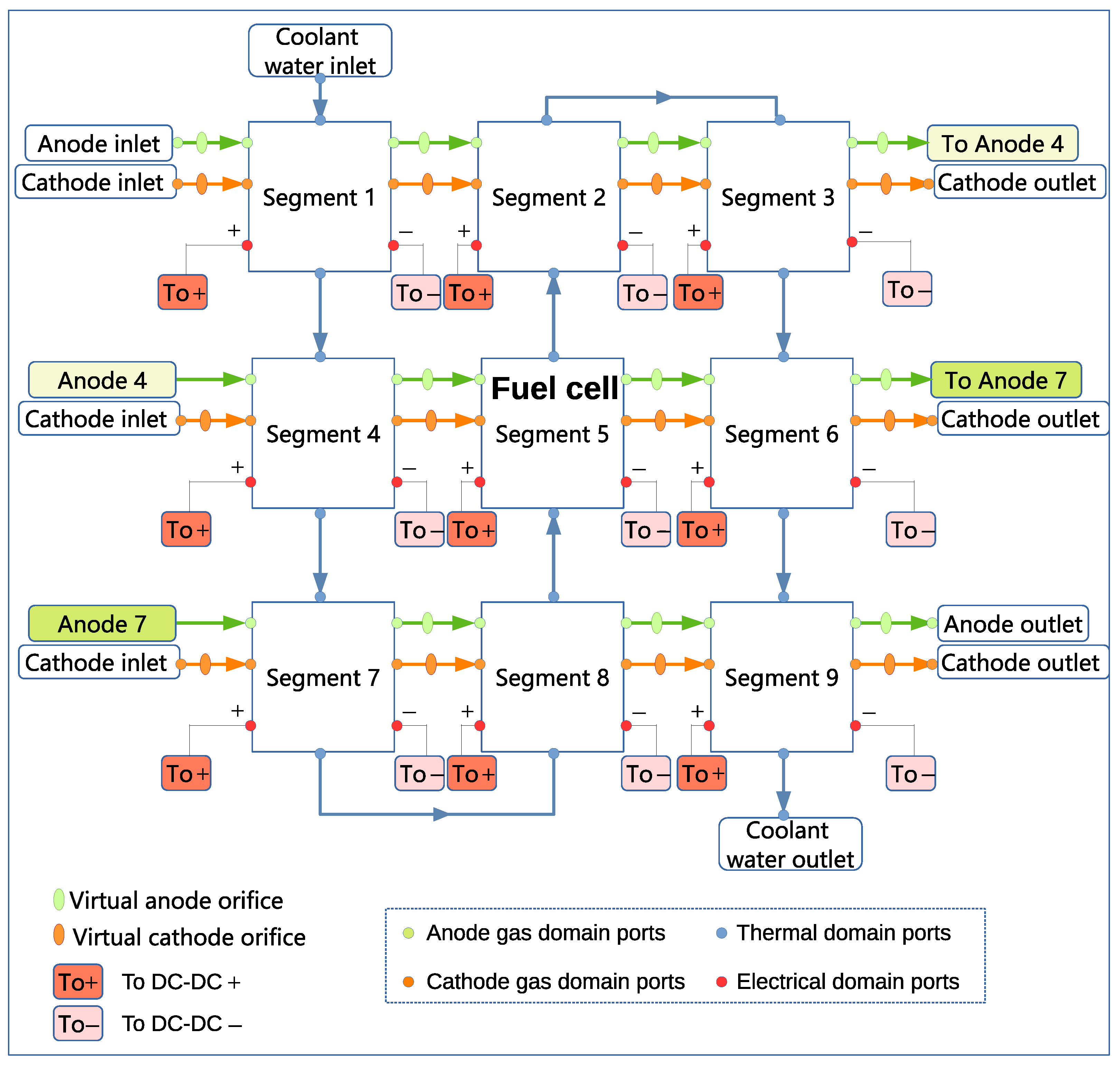
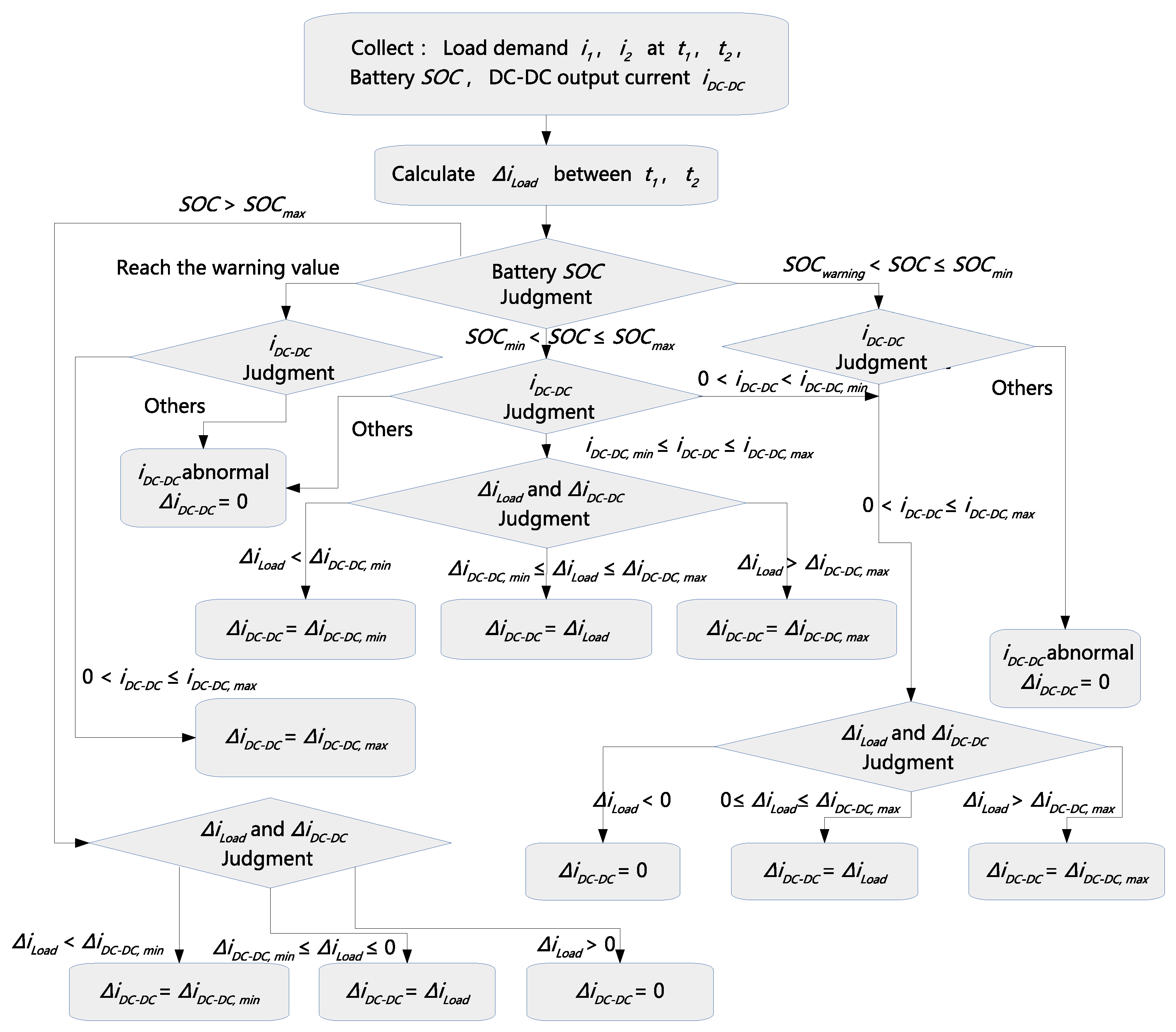
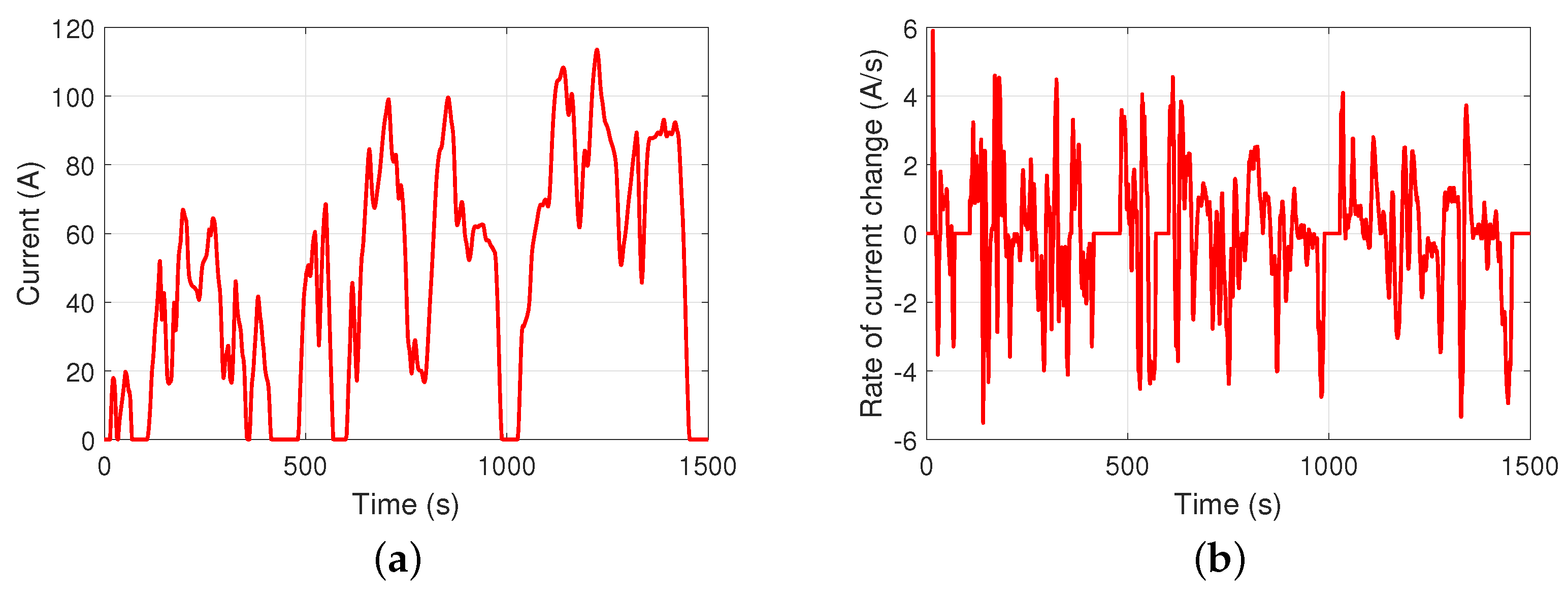


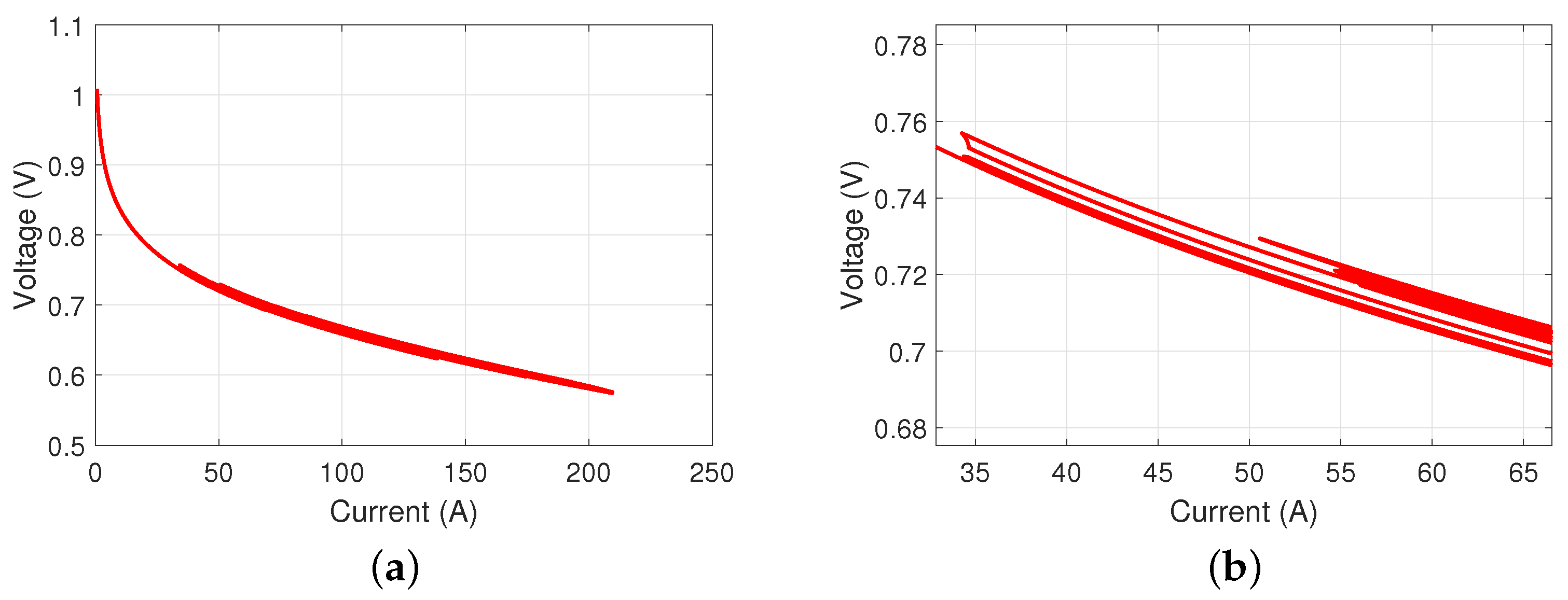
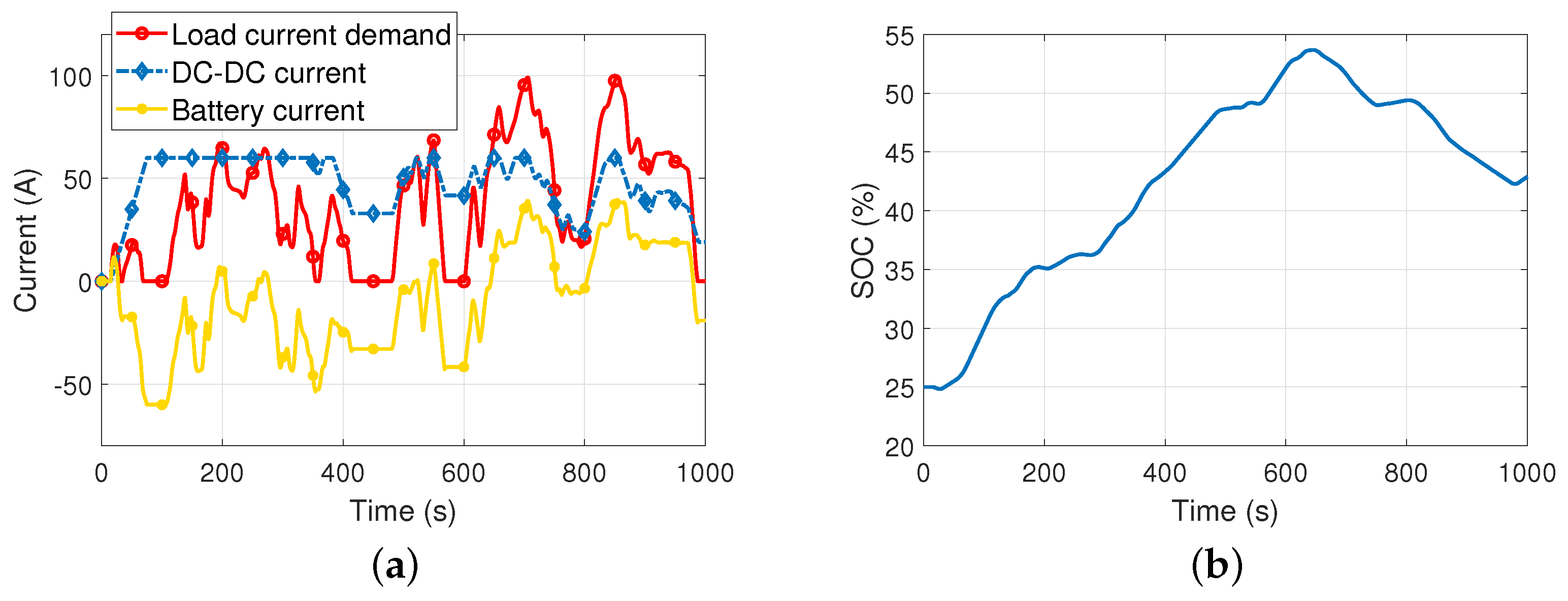

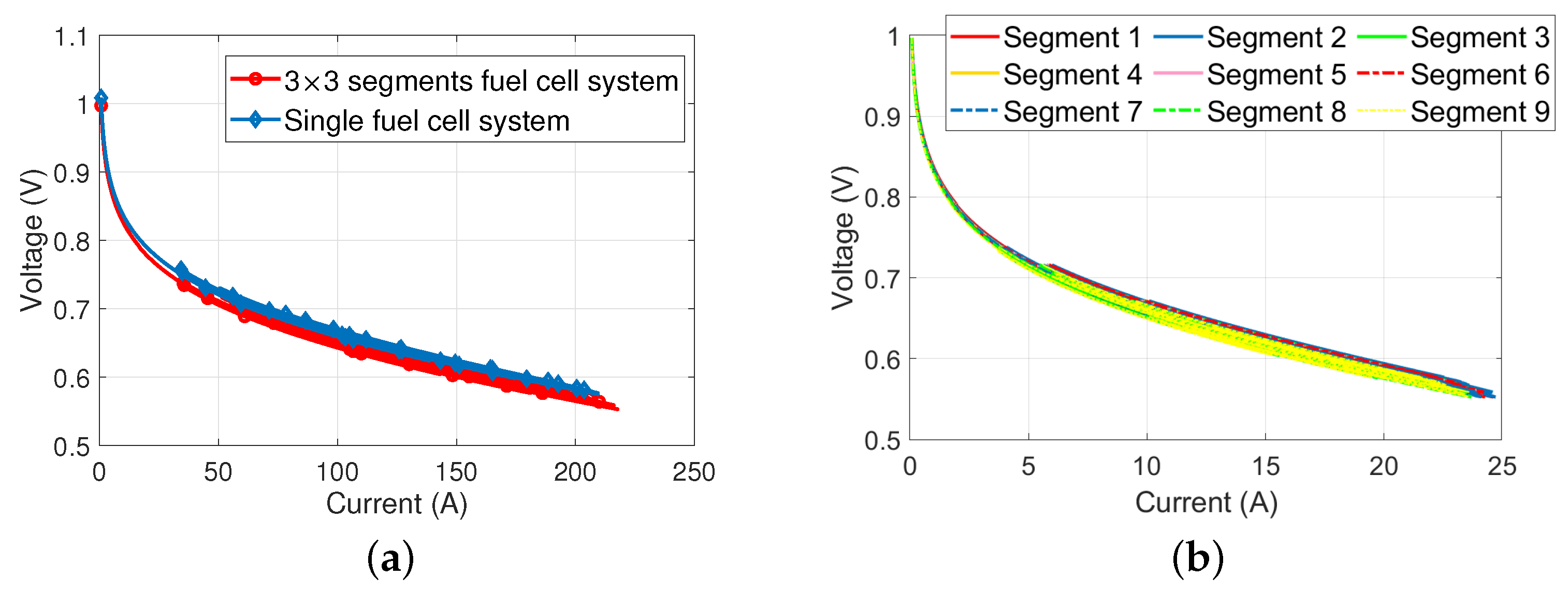
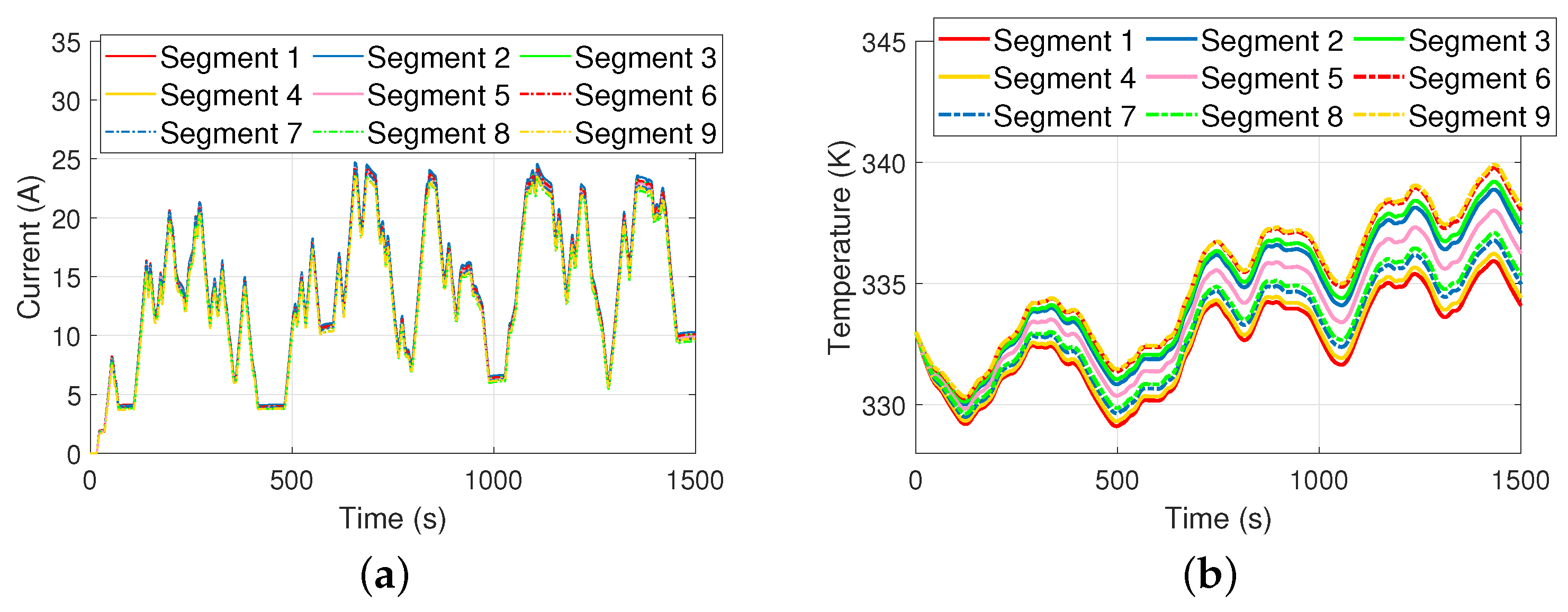
| Parameters | Values | Parameters | Values |
|---|---|---|---|
| 10 A | 60 A | ||
| A/s | 1 A/s | ||
| Fuel Cell in Hybrid Power System | Max Current/A | Max Temperature/K | Only a Fuel Cell | Max Current/A | Max Temperature/K |
|---|---|---|---|---|---|
| Segment 1 | Segment 1 | ||||
| Segment 2 | Segment 2 | ||||
| Segment 3 | Segment 3 | 356 | |||
| Segment 4 | Segment 4 | ||||
| Segment 5 | 338 | Segment 5 | |||
| Segment 6 | Segment 6 | ||||
| Segment 7 | Segment 7 | ||||
| Segment 8 | Segment 8 | ||||
| Segment 9 | Segment 9 | ||||
| Average | 338 | Average | |||
| Variance integral (nondimensional) | 1561 | Variance integral (nondimensional) | 3839 |
Disclaimer/Publisher’s Note: The statements, opinions and data contained in all publications are solely those of the individual author(s) and contributor(s) and not of MDPI and/or the editor(s). MDPI and/or the editor(s) disclaim responsibility for any injury to people or property resulting from any ideas, methods, instructions or products referred to in the content. |
© 2023 by the authors. Licensee MDPI, Basel, Switzerland. This article is an open access article distributed under the terms and conditions of the Creative Commons Attribution (CC BY) license (https://creativecommons.org/licenses/by/4.0/).
Share and Cite
Huang, L.; Ouyang, Q.; Chen, J.; Liu, Z.; Wu, X. A Scalable Segmented-Based PEM Fuel Cell Hybrid Power System Model and Its Simulation Applications. Energies 2023, 16, 6224. https://doi.org/10.3390/en16176224
Huang L, Ouyang Q, Chen J, Liu Z, Wu X. A Scalable Segmented-Based PEM Fuel Cell Hybrid Power System Model and Its Simulation Applications. Energies. 2023; 16(17):6224. https://doi.org/10.3390/en16176224
Chicago/Turabian StyleHuang, Lianghui, Quan Ouyang, Jian Chen, Zhiyang Liu, and Xiaohua Wu. 2023. "A Scalable Segmented-Based PEM Fuel Cell Hybrid Power System Model and Its Simulation Applications" Energies 16, no. 17: 6224. https://doi.org/10.3390/en16176224
APA StyleHuang, L., Ouyang, Q., Chen, J., Liu, Z., & Wu, X. (2023). A Scalable Segmented-Based PEM Fuel Cell Hybrid Power System Model and Its Simulation Applications. Energies, 16(17), 6224. https://doi.org/10.3390/en16176224







